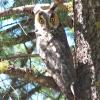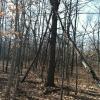Leaderboard
Popular Content
Showing content with the highest reputation on 12/30/2016 in all areas
-
At this point I've jumped off the migration bandwagon if, by "migration" you mean long distance seasonal travel. I do think they relocate within their range seasonally but it's a much shorter trip, probably 20-50 miles, not the hundreds I used to surmise. So .. why the change of heart? Deeper study of the report data. What I saw was a long, somewhat thin. concentration of reports along a long mountain range. It seemed to end at a location which has a long history. Such a migration, mapped in time, should present a traveling wave of sightings ... and it didn't. Instead the activity "fired off" from one end of the range to another across well over 1000 miles. That's too far for weather change or other seasonal factors to affect all at once as well because the range runs N-S. The only thing that makes any sense is an astronomical trigger, something that appears simultaneously at all latitudes. Further study later also showed that there's a spike of activity at the south end of the area in mid summer, exactly out of phase with the presumed migration. Today I suspect that there are "migrations" up and downhill, changes in elevation to take advantage of resources or avoid weather, but the actual distance traveled is pretty short. This makes a lot of sense because it would mean that the Cascades where I am could have the same general pattern as the Rockies where it's pretty much too far for even a bigfoot to travel to get out of the snow. Interestingly enough, away from the mountains themselves, the number of sightings stays pretty constant year around whether it's 90 degrees or approaching 10 below suggesting extreme adaptation to variable climate ... so long as food is accessible. For now, I'd say there are "bands", for lack of a better word, which stay in the same general area but move up or down in elevation to follow food. It doesn't stop there. Some of the habituators I have worked with say that their local "band" is there most of the year fairly constantly but that at certain times of the year, or sometimes every second or third year, the same small group of traveling 'foots, probably sub adult and young adult males, pass through. They're often recognizable and predictable in their timing. I note that that would be a useful behavioral adaptation for a small, spread out population to keep the genes mixing. I don't think anyone knows for sure, though, that's just my current interpretation of behavior, timing, data, etc. I changed my mind once before, I may change it again. MIB2 points
-
I see where you're going ... Yep. That. My great grandfather would never let us kill a porcupine or grouse because they were slow and "dumb" enough that a person in an emergency situation could kill one and stay alive ... basically leaving the emergency rations on the table. We also seldom hunted right at home, we left the pet yard deer alone though occasionally using the does as live decoys to draw in big "stranger" bucks that wandered by once the rut started. Interestingly enough, as my father has gotten older and less able to roam far distances, he becomes ever more willing to plug a deer on the lawn (legally) ... sort of what we're saying the BF might do as their abilities to hunt afar are taxed by weather, injury, illness, or old age. Y' don't have to think about this too long before you start to realize they're doing exactly what we would, or do, do, when confronted with the same situations, limitations, and opportunities. "Hmmm." Yep. I don't have a right label, but that's the general "flavor." Something capable of our level of intelligence yet very seldom employing even stone-age level of technology. (I say seldom, not never, because they seem capable of borrowing at least some of our tools and understanding how to use them at times.) It's an interesting dichotomy causing some people great heartburn when the binary world view they hold is confronted with something that refuses to fit. MIB1 point
-
I agree in full, and I'll go you one just a bit further - it hit me that the side of the mountain we were on had tons of deer - and they were there hunting and watering. At our feet was a huge valley with a few large valleys offshooting from the big one, and these things were full of deer. On the other side of the mountain - another really huge valley - lots of water and most likely tons of deer. I got the impression they lived on the steeper side, but came over during the Spring, Summer, and Fall to hunt outside their home valley. The purpose is to not disturb the game close to their lower elevation crib - enabling them more ready access when everything was snowed in. That's done by many outfield settlers in Alaska. They'll go afar to hunt during late Spring through the first snows - and not bother the game closer to their cabin - enabling shorter winter hunting distances. So for them to be seen more frequently on ridges - it may be because they're 1.) skylighted easier, and 2.) they're crossing from their "home" area to hunt the other side of a mountain or ridge - "saving" the game on their side for winter hunts. I hold that these things are some primitive man. Not human - certainly not ape - but a primitive, cave-man-type man. Smart, clever, and thinking.1 point
-
In the lower 48, unless you're in Idaho, Montana or Wyoming (especially Yellowstone) your chances of seeing a grizzly (brown bear) are probably lower than seeing an actual sasquatch elsewhere, according to sighting reports.1 point
-
Interesting study. But I am with Redbone on the conclusions from the data used. I will use the state of Washington in your core area for example. A human population density of +101 /sq mi gives a very skewed view of the state as a whole. Half the population lives in only three counties of the 39 in the state. If you go down to the county level using Skamania county for an example (one of the highest sighting areas in the state) the population density is <7. That is a huge difference from the stated value for the state. That figure is closer to the reality of what is seen in the remote areas of the state even during the summer when outdoor recreation is at a high. The huge majority of people in the higher population areas will never leave those areas seasonally to increase the population densities in the more remote places. The same holds true in Oregon as well. Some of them might go to the beach during the summer or to a ski resort in the winter but an occasional camping trip or a drive down one of the interstates is the most influx you will see. Main arterial usage numbers would probably be a better data set to use, as Explorer has done with his studies. The bear population is skewed in the other direction. Because the state of WA is not all bear habitat. Only about half of it is. Therefore doubling the bear population in actual available habitat. Again Oregon is about the same. As Redbone mentioned there is a big difference between the urban and rural population. And available habitat should be considered. This is going to change the analysis and the conclusions.1 point
-
Here's where you lost me. You're basically saying that all reports in Minnesota and Iowa are hoaxes because they fall into group B. I disagree. (I don't care as much but the logic also applies to Michigan, Illinois, Ohio, and Wisconsin) While the methods you used might be sound, the data really needs to be adjusted. Here a few reasons I think the conclusions are off. 1. There are many encounters in Iowa that remain out of the public BFRO data base because they'd give up expedition locations. You'll see some of them when Finding Bigfoot Iowa gets aired. I can think of 7 or 8 encounters that happened while I was present, that would all be good enough to make it into the database (knocks, whoops with audio, and class B sightings which as shown in your report cannot really be attributed to black bear). In Minnesota, the BFRO presence has dropped off to form other groups that are taking reports and holding expeditions (one of which I am a part of). Reports that they receive don't make it into the BFRO database. When Finding Bigfoot rolled into Minnesota they looked to at least one of these other groups for potential locations and witnesses. 2. If your conclusions are somehow based on population, it needs some tweaking. The residents of Des Moines and Minneapolis/St Paul make up a large population percentage of both states, but the sightings are (generally) far away from those big cities. If you want to conclude that Des Moines and Minneapolis suburban sightings are hoaxes I can live with that. Take away those big cities and your population density for the rest of the state falls off greatly I'd suspect, and mostly likely changes the conclusions. (same argument for Illinois, Ohio, Michigan, and Wisconsin) 3. I think you somehow need to account for percentage of forest each state has. Iowa has more forest than you'd suspect, but I'd guess it's a pretty low percentage of total area compared to come other states. I'd like to know how the sightings per square mile of forest works out for all the states. (I may look into that actually) That might work in Iowa's favor but hurt Minnesota. 4. South Dakota as an A' while Iowa, Minnesota, Ohio, Illinois, and Wisconsin are all 'probable hoaxes' is a huge red flag. Sioux Falls must not be large enough. There's probably more and I don't have the know-how to figure out exactly how this all fits in. I just know the initial conclusions don't fit my view of reality. Edit: I left off rain totals, which I'm pretty certain matter greatly...1 point
-
Because only Biggie is telepathically telling them to leave apples on the back fence posts,duhh! I mean whose crazy enough to believe a rabbit could ask for carrots???1 point
-
I've always said that a man can get used to almost anything - but that takes time, repetition, and resignation. Which assumes a relatively constant, repetitive condition - and these things are anything but consistent. My natural tendency is to subordinate my fear and work the problem. I found the experiences very unsettling - each and every time. Get down to it - I don't like these things. Not even a little bit. Their behaviors are counter-intuitive, and I'd have to likewise become counter-intuitive until counter-intuitive personal behavior became intuitive. And that would take time. But that's just me.1 point
-
The average female bear has around 10-15 cubs in her lifetime. I ran across that some time back but after looking this time around I was unable to find the information. If the bear is malnourished then that number drops. For large animals we only have bears to help us assume how many offspring a Sasquatch may produce. Two-three every two years like bears ? Mostly one at a time like Humans? Habitat that can provide nutritional needs is important of course but so is the rate of birth. There have been discussions on that subject that endeavored to look for those answers but like with everything else about the creature it was mostly circumstantial.1 point
-
I for one think that its numbers have been stable for a long period of time, but perhaps they are not nearly as numerous as before homo sapiens rise. Native Americans reported these creatures being present in numbers when they came across the Bering Sea land bridge, so we know they were here before the modern humans, stories of wars between tribes and Sasquatch over territory have been told, of having to drive the Sasquatch off of the plains and into the mountains. If such things were true, and Sasquatch were numerous and thriving prior to our contact, then it is hard to imagine anything but a decline since that hey day of existence. Looking at other animal populations, there were definite decreases after the presence of modern humans arrived, including deer, buffalo, elk, moose, et., mostly due to hunting but also destruction of habitat. That destruction of habitat and over harvesting continued into the 20th century, but then declined as laws protecting the environment and overharvesting were enacted. Since those laws were put into place many animal species have rebounded, and I think most likely this could explain an apparent recent rise in the Sasquatch population. More and more open space is being preserved and protected, that can only lead to a higher population of these creatures over the long haul, but I think if it were graphed out, it might show a sudden decline due to disease when white men came to our continent, and a slow continual increase since then, perhaps a minor spike in our century has occurred.1 point
This leaderboard is set to New York/GMT-05:00






